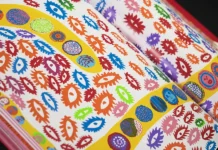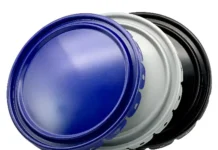by William Goughenour, Jr., Wood Coatings Expert

UV-curable inks have long been a standard in the digital printing industry, so there’s been a vested interest in science and research dedicated to the formulation and application of UV-curable inks and UV-curing technology. A wide range of market trends and coatings performance criteria have been driving research and development in the areas of UV wood coatings and roll coating technologies.
In the signage and display manufacturing sectors, an increased demand for laminating from a plastic or paper substrate on to a structurally stronger substrate has resulted in research and development for delamination solutions. In the furniture industry, digital printing has been flourishing as an economic alternative for artistic finishes and details that once were handcrafted by artisans.
This article focuses on UV-curable roll coating material on various types of wood and paper laminated to wood substrates that are compatible with many of the digital printing inks and processes being used in the digital printing industry. Many manufacturers are requiring a more rigid printable substrate, which provides them with processes that can be custom-tailored to meet their customers’ needs without having to post-apply printed artwork to various substrates, thus eliminating the delaminating issues associated with older processes. There are as many lamination options for impregnated and non-impregnated papers as there are types of ink to use.
To further complicate the issue, one size of paper and ink does not fit all. Due to the many coefficient values of clear or pigmented UV-coated substrates in relationship to ink types, each ink presents too many potential adhesion challenges to only offer a single UV roll coating material alternative to treat these surfaces. Another barrier is the fact that some manufacturers also need to have the ability to affix vinyl media.
Vinyl lettering and graphic art seem to work best on glossier surfaces – as opposed to extremely low sheen surfaces – unless specialized proprietary resins are used to accommodate the proper tack at the lower sheen. However, in general terms, higher gloss values will aid in affixing vinyl materials.

With that vinyl lettering criteria aside, what has been discovered in relation to UV roll coating options to treat the surface? Roy Pagan, business development manager at Cefla North America, shared that the key to a successful bond for digital printing is to obtain ink with a high surface tension and a substrate that has a high surface energy. Without these two components, a desirable cohesive bond will not be achieved. This will result in ink reticulation – ink droplets will gather randomly as opposed to uniformly – before UV curing, causing the base substrate to show through. In addition, there will be low to no adhesion to the base material, which is a leading contributor of poor resolution and printing registration. This would be unacceptable in today’s high definition-driven world.
UV materials have been developed to serve as conducive conduits for inks to properly adhere to paper and wood treated surfaces. A multiplicity of physical attributes are required in these industries – and those attributes are not solely related to the printing process. As previously mentioned, surface tension also needs to satisfy good tractability for vinyl lettering.

Sheen of the UV roll coat material plays a major factor in the success of the ink adhesion, with the most favorable results ranging in nature from 10° to 20° sheen with a 60° sheen meter. As coating technologies are developed, surface tension is validated by dyne pens and contact angles in conjunction with ASTM D2578 standards in relation to various surface tensions ranging from 30 through 60 dynes. A range of 36 dynes on the low side to 60 dynes on the high side seems to provide optimal digital printing adhesion success with most of the digital inks currently available on the market. As seen in Figure 1, the higher the number of the Dyne pen, the greater the related issue of surface tension is highlighted with the UV coating. Note how the ink begins to bead up and draw away from the surface starting at the 46 Dyne mark and increasing to 60 Dyne range? In Figure 2, the UV coating was slightly modified to slightly lower the surface tension, resulting in improved surface tension and a wider range of acceptable targets. Finally, in Figure 3, the UV coating was modified to offer a wide range of Dyne with no noticeable reticulation, which is ultimately the goal in the printing industry.
The process to prepare the substrate for printing can be divided into a few categories. Once the wood surface or the appropriate paper has been laminated to the substrate, apply a white or black 10° or 20° sheen roll coat material through a reverse roll coat wet-on-wet process – generally at a rate 15-20 grams per square meter or as specified using a gel cure between each coat at 150 millijoules UVA. After the second coat is applied, full cure at 400 millijoules UVA/UVV as applicable. Sand the surface with 400-600 grit dual platen wide belt sander to the desired surface smoothness without raising additional paper or wood fiber.
A second coat using the same process provides the best masking or aesthetic result to achieve a good solid white or black background on which to print. Following the printing process, a pre-determined sheen final clear coat of UV typically is applied via a reverse roll coat process at 15-30 grams per square meter or as specified to satisfy the build or aesthetic aspect. A final clear coat applied over the digital printing likely will enhance the crispness or definition of the printing.
This represents one process utilized by large-scale manufacturers with the ability to apply the UV coating and printing all at one time and in one location. It is important to note that line speeds, durometer of the roller and millimeter contact pressure also are critical.
During initial testing, it was discovered that when resin-impregnated or non-impregnated papers were laminated to plywood or various other cores, the contact pressure of a proper durometer roller also was extremely crucial. When too much pressure was applied, the grain of the ply-core and other types of core telegraphed throughout the entire process. So, the challenge is to apply enough material without compromising this issue, which would lead to a surface that is aesthetically unappealing.
The final process targets wood and paper products that are purchased and then digitally printed in the aftermarket. This group of customers is looking for alternative printable substrates that offer a wider spectrum than just the traditionally used paper or plastic substrates. The manufacturing process of the aftermarket product is similar to the previously illustrated process. The main difference is that the 10° to 20° sheen black or white UV base color coats then are coated with a final specialized clear UV roll coat custom designed to be compatible with the customer’s specific digital printing inks and performance criteria. These substrate products then are sold and printed worldwide.
The digital printing age is here to stay, and emerging technologies will continue to allow many market sectors to offer quality graphics at economical prices and on a wider range of substrates than ever before. There are many additional emerging trends that utilize UV roll coat inert equipment, and I hope to discuss them in more detail in a future article.
William H. Goughenour, Jr., is an internationally recognized expert in all aspects of wood coatings technology, from management and technical training to process and design, delivery and the operation of specialized equipment. His passion for research and development has led to the development of the first 100% waterbased patina for the picture frame industry, the first MDF picture frame molding design incorporating UV, a flame-retardant wall paint system for SIPs and developing a 100% UV gesso primer system reducing dry cure times from days to hours for MDF molding in China. He has developed and managed projects by major universities across the US and internationally, including a multimillion-dollar laboratory to conduct coatings research. Contact William Goughenour at woodfinish@att.net.






